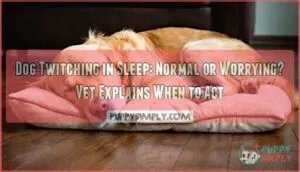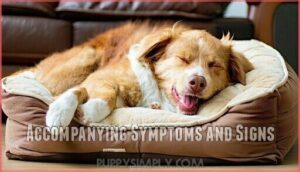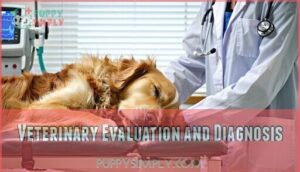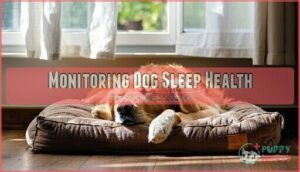This site is supported by our readers. We may earn a commission, at no cost to you, if you purchase through links.

About 85% of healthy dogs experience these gentle movements as they dream, with their brains’ muscle paralysis systems having occasional "glitches" that let dream actions leak through.
Your pup’s legs might paddle through invisible chases or their whiskers twitch at phantom squirrels—completely normal and endearing behavior that typically lasts about a minute every 20 minutes during deep sleep.
However, distinguishing between harmless dream twitches and concerning seizure activity requires knowing specific warning signs and patterns.
Table Of Contents
- Key Takeaways
- Dog Sleep Twitching
- Why Dogs Twitch
- Twitching Vs Seizures
- Dog Sleep Patterns
- Health Factors and Twitching
- Identifying Abnormal Twitching
- Dog Dreaming and Sleep
- When to Seek Veterinary Care
- Improving Dog Sleep Quality
- Monitoring Dog Sleep Health
- Frequently Asked Questions (FAQs)
- Why do dogs twitch in their sleep?
- What does it mean when a dog Twitch?
- Should I Wake my dog up if he twitches?
- Why do puppies twitch when they dream?
- Do dogs twitch during REM sleep?
- Why does my puppy Twitch a lot?
- Can certain dog breeds twitch more frequently?
- Do dogs remember their dreams after waking?
- Is twitching more common in certain seasons?
- Can diet affect dog sleep twitching patterns?
- Conclusion
Key Takeaways
- Most sleep twitching is normal dreaming behavior – You’ll see gentle leg paddling, facial movements, and soft vocalizations lasting 5-30 seconds during REM sleep, which indicates healthy brain activity in about 85% of dogs.
- Learn to distinguish twitching from seizures – Normal twitching involves brief, isolated movements with flexible limbs while your dog responds to your voice, whereas seizures cause prolonged, violent convulsions with rigid limbs and loss of consciousness.
- Puppies and seniors twitch more frequently – You’ll notice increased twitching in young dogs due to developing nervous systems and in older dogs from weakened neural pathways, both of which are typically normal for their life stages.
- Seek veterinary care for concerning signs – Contact your vet immediately if you observe twitching lasting over a minute, violent movements, loss of bladder control, excessive drooling, or seizures lasting more than five minutes.
Dog Sleep Twitching
You’ve probably noticed your dog’s legs paddling or tail wagging while they sleep and wondered if it’s normal.
Most sleep twitching occurs during REM sleep when dogs dream, involving brief muscle movements that last 5-30 seconds and indicate healthy brain activity.
Those gentle leg kicks and tail wags during sleep? Your pup is simply dreaming healthy dreams.
Normal Twitching Behavior
Why does your dog twitch during sleep? You’re witnessing normal twitching behavior that’s part of healthy Dog Sleep Patterns.
Sleep twitching occurs naturally when muscle relaxation signals from the brain stem create involuntary movements. These Twitching Triggers include dreaming, shifting between sleep cycles, and environmental stimuli.
Normal dog twitching in sleep typically affects legs, head, and tail, lasting 5-30 seconds. This behavior indicates good Sleep Quality and proper REM sleep function.
REM Sleep Stage
During REM sleep, your dog’s brain waves mirror those of an awake state while their body remains still. This stage showcases the most vivid dream patterns and intense neural signals.
You’ll notice specific REM activity indicators:
- Rapid eye movements beneath closed eyelids
- Irregular breathing patterns and heart rate changes
- Muscle twitching in paws, face, and tail
- Soft vocalizations like whimpers or quiet barks
- Complete muscle relaxation preventing full dream enactment
This sleep stage accounts for most dog twitching episodes and is characterized by rapid eye movements and irregular breathing.
Muscle Relaxation Signals
The brain stem acts as your dog’s sleep control center, sending neural signals that trigger muscle relaxation during REM sleep patterns.
This relaxation response prevents your pup from physically acting out dreams, though some muscle spasms slip through.
When muscle control systems partially "switch off," you’ll notice gentle twitching as these signals create the perfect balance between deep sleep and safety, allowing for a relaxation response.
Why Dogs Twitch
Understanding why your dog twitches during sleep helps you distinguish between normal behavior and potential health concerns.
Most sleep twitching occurs during REM sleep when your dog’s brain remains highly active while processing dreams and memories.
Dreaming and Brain Activity
Your dog’s brain waves during REM sleep mirror human patterns, triggering neural activity that creates vivid dreams.
Your dog’s dreaming brain creates the same vivid sleep patterns as your own mind.
These sleep cycles activate cognitive function while the brain stem sends signals causing muscle spasms and twitching.
Dream stages involve intense processing where your pup likely relives daily experiences – chasing squirrels or learning new tricks.
This dog twitching in sleep reflects healthy dreaming in dogs and normal REM sleep function.
Understanding brain health issues can help you identify potential problems with your dog’s sleep patterns, including issues related to brain health and the dream state.
Startling and Environmental Stimuli
External sounds can jolt your sleeping dog into sudden twitching episodes.
Noise triggers like thunderstorms, fireworks, or sirens create startle responses that manifest as involuntary muscle movements.
Environmental factors including temperature changes and unfamiliar surroundings amplify these sleep disturbances.
Your dog’s nervous system remains partially alert during rest, making them susceptible to stress effects from unexpected stimuli that interrupt their peaceful slumber.
Muscle Spasms and Development
Young canines experience puppy spasms as their nervous systems mature, making muscle growth-related twitching completely normal.
These development stages bring spasm frequency that differs from adult patterns, while senior spasms often indicate weakening neural control.
- Puppy Development: Growing nervous systems create natural muscle spasms during sleep
- Growth Phases: Different development stages show varying spasm frequency patterns
- Senior Changes: Aging dogs experience increased twitching from weakened muscle control
- Normal Variation: Spasm intensity changes throughout your dog’s life stages
Twitching Vs Seizures
While your dog’s gentle sleep twitching is usually just a sign of healthy dreaming, you need to know when those movements cross the line into something more serious.
Recognizing the difference between normal twitching and seizures can help you respond appropriately and keep your pet safe.
Key Differences
How can you tell if your dog’s nighttime movements are harmless dream signs or serious seizure symptoms? Understanding these key differences helps you respond appropriately when your pup starts twitching.
| Normal Sleep Twitching | Seizure Activity |
|---|---|
| Brief, isolated movements (5-30 seconds) | Prolonged, violent convulsions |
| Flexible limbs, relaxed body | Rigid, stiff limbs |
| Responds to gentle voice calls | Unconscious, unresponsive |
| Intermittent leg paddling, facial twitches | Generalized full-body tremors |
| Normal breathing, peaceful expression | Labored breathing, distressed appearance |
Normal dog twitching during sleep patterns involves gentle, brief movements affecting specific body parts. These twitch types indicate healthy brain activity and dream signs.
Seizure symptoms present as uncontrollable, generalized movements with loss of consciousness, requiring immediate veterinary attention. Dogs exhibiting unusual behaviors may also experience tear duct issues that can affect their overall eye health and comfort.
Seizure Symptoms and Signs
Recognizing seizures in dogs requires understanding distinct warning signs that differ dramatically from normal sleep twitching. Unlike gentle dream movements, seizures create violent, uncontrollable convulsions throughout your dog’s body.
It’s essential to identify seizure causes to provide proper care and attention to your dog’s health.
| Phase | Symptoms | Duration |
|---|---|---|
| Pre-Seizure | Restlessness, staring, unusual behaviors | Minutes to hours |
| Active Seizure | Loss of consciousness, rigid limbs, paddling | 1-5 minutes |
| Post-Seizure | Disorientation, confusion, temporary blindness | Minutes to 24 hours |
| Focal Seizures | Repetitive twitching, facial spasms | Variable |
| Emergency Signs | Seizures over 5 minutes, difficulty breathing | Immediate action |
Watch for seizure triggers like excessive drooling, involuntary urination, and muscle spasms that affect your dog’s entire body rather than isolated limbs.
Emergency Veterinary Care
When your dog experiences seizures, immediate veterinary care becomes paramount.
Contact your emergency veterinarian or poison control if toxins are suspected. During seizures in dogs, avoid restraining your pet—status epilepticus requires urgent crisis management.
| Immediate Actions | Avoid These Mistakes |
|---|---|
| Time the seizure duration | Don’t restrain your dog |
| Clear surrounding hazards | Avoid putting hands near mouth |
| Contact emergency vet immediately | Don’t wait for multiple episodes |
First aid focuses on safety while professional veterinary care addresses underlying causes.
Dog Sleep Patterns
Understanding your dog’s sleep patterns helps you recognize when twitching is normal versus concerning. Dogs experience distinct sleep cycles that influence when and how they twitch during rest.
REM and NREM Sleep Cycles
Understanding sleep stages helps explain why dog twitching in sleep occurs naturally.
Your dog experiences REM sleep and NREM sleep cycles, just like humans do.
During REM patterns, intense dream activity triggers brain waves that cause those familiar leg kicks and soft whimpers.
Sleep cycle shifts between these stages create the perfect conditions for twitching episodes.
Puppies and Senior Dogs
Age brings unique sleep characteristics that affect twitching patterns in dogs.
Puppies experience frequent twitching during sleep due to developing nervous systems and active Puppy Development processes.
Their immature brain control mechanisms haven’t fully matured, making puppy twitching more common during REM cycles.
Senior dogs also show increased dog sleep twitch episodes as Age Factors weaken neural pathways controlling muscle inhibition.
Both life stages require careful monitoring of Sleep Patterns to distinguish normal senior dog shaking from concerning symptoms requiring Senior Care attention.
Understanding dog sleep patterns is essential for identifying potential issues in canine health.
Sleep Position and Twitching
Your dog’s sleep posture directly influences twitch frequency and sleep movement patterns.
Dogs stretched out on their sides experience more pronounced twitching than those curled up in tight balls.
This body alignment allows greater muscle relaxation, making sleep twitching more visible during REM phases.
When your pup sprawls across the couch, expect more leg paddling and facial movements compared to their compact sleeping positions, which can indicate a deeper level of relaxation.
Health Factors and Twitching
While normal twitching during sleep is usually harmless, certain health conditions can make dogs more prone to concerning episodes.
You’ll want to recognize when underlying medical issues, toxins, or stress might be turning innocent dream movements into something that requires veterinary attention.
Medical Conditions and Toxins
Several underlying health conditions can trigger abnormal twitching during your dog’s sleep.
Neurological disorders like epilepsy and encephalitis disrupt normal brain function, causing involuntary muscle movements that extend beyond typical dream-related twitching.
Toxic exposure from chocolate, xylitol, or pesticides creates poisoning effects that manifest as tremors and seizures.
Organ diseases affecting the kidneys, liver, or heart can compromise neurological activity, while medication side effects from antibiotics or anti-anxiety drugs may increase twitching frequency.
Metabolic conditions like diabetes and hypoglycemia also contribute to abnormal muscle responses during rest periods.
Regular veterinary check-ups can help identify and address common pet issues, including pet health problems, to prevent or manage such neurological disorders and medication side effects.
Anxiety and Stress
Emotional turbulence affects your dog’s sleep just like it does yours. When dogs experience chronic stress or anxiety, their nervous systems remain hyperactive, leading to increased twitching during sleep.
This heightened state disrupts normal rest patterns and can make dream-related movements more intense.
Common stress triggers that amplify sleep twitching include:
- Separation anxiety – Dogs left alone frequently show restless sleep with excessive movement
- Environmental changes – Moving homes, new family members, or schedule disruptions create ongoing tension
- Loud noises – Thunderstorms, fireworks, or construction sounds trigger stress responses that persist into sleep
Dog anxiety manifests through various signs including pacing, excessive panting, and disturbed sleep patterns.
Calming techniques like consistent routines, comfortable sleeping spaces, and relaxation methods help reduce stress-induced twitching. Emotional support through gentle reassurance and anxiety management creates better sleep quality for your pet.
Identifying Abnormal Twitching
While normal sleep twitching is harmless, you’ll need to recognize when your dog’s movements cross into concerning territory.
Abnormal twitching involves prolonged episodes, violent movements, or signs that suggest your pet is experiencing distress rather than peaceful dreams.
Prolonged or Violent Twitching
When twitching episodes stretch beyond 30 seconds or involve violent movements, you’re witnessing potential seizure triggers rather than normal sleep behavior.
Prolonged twitching and muscle spasms during sleep disturbances signal underlying twitching disorders that require immediate attention.
Unlike gentle dream paddling, violent twitching in sleep involves rigid limbs and uncontrollable movements that can’t be easily interrupted, indicating a possible sleep disturbance.
Accompanying Symptoms and Signs
Beyond muscle spasms and involuntary muscle spasms, watch for concerning signs accompanying your dog’s sleep twitching.
Vocalizations like intense whimpering, distressed barking, or howling suggest something’s wrong.
Violent paddling movements, persistent tremors, and full-body shudders indicate abnormal activity.
Look for rigid limbs, labored breathing, drooling, or loss of bladder control, which are signs of potentially dangerous behaviors, including loss of bladder control.
These symptoms distinguish dangerous twitching from normal dreaming behaviors.
Veterinary Evaluation and Diagnosis
When you notice concerning symptoms alongside dog twitching, schedule a veterinary evaluation promptly.
Your veterinarian examination will include a thorough symptom assessment and diagnostic process using specialized diagnostic tools.
The vet consultation involves reviewing your dog’s medical history, observing twitching patterns, and distinguishing between normal canine behavior and potential dog seizures.
Medical tests may include blood work, neurological assessments, and imaging studies to rule out underlying conditions causing abnormal twitching episodes, which is a crucial part of the diagnostic process and helps in identifying the root cause of the abnormal twitching.
Dog Dreaming and Sleep
Just like humans, dogs experience vivid dreams during REM sleep that can cause their bodies to react physically.
Understanding your dog’s sleep patterns helps you recognize when dream-related movements are normal versus when they might signal a sleep disorder requiring attention.
REM Sleep Behavior Disorder
REM Sleep Behavior Disorder transforms peaceful dog twitching in sleep into something more dramatic.
Unlike normal REM sleep where sleep paralysis prevents movement, REM disorder allows dogs to physically act out their dreams.
Brain signals that should inhibit muscle movement fail, causing sleep violence including intense running, barking, or even biting.
These episodes affect 91% of dogs with violent limb movements during REM sleep patterns, making canine sleep behavior unpredictable and potentially dangerous.
These changes highlight the importance of understanding REM Sleep Behavior Disorder in dogs to ensure their safety and the safety of those around them.
Acting Out Dreams
Unlike gentle sleep twitching, some dogs physically act out their dreams with intense movements.
During REM stage episodes, your dog might run, bark aggressively, or show violent leg paddling while remaining unconscious.
This REM Sleep Behavior Disorder involves complex dog behavior where brain activity fails to inhibit muscle responses.
Dream analysis reveals these episodes reflect active sleep patterns, making dog dreaming appear dramatically real through pronounced dog twitching sequences, which can be characterized by intense movements and violent leg paddling.
Sleep Quality and Duration
How do sleep patterns affect your dog’s twitching frequency and overall rest quality? Understanding these connections helps you recognize when your pup’s getting the restorative sleep they need.
- Sleep Cycles: Dogs complete 90-minute cycles alternating between REM and deep sleep phases
- Dream Duration: REM periods last 5-20 minutes, with most dog twitching occurring during these phases
- Rest Quality: Consistent sleep patterns indicate healthy neurological function and proper relaxation techniques
- Sleep Disturbances: Frequent interruptions can increase twitching and reduce overall sleep quality
Recognizing dog sleep patterns is essential for identifying potential issues with your dog’s rest quality and overall health.
When to Seek Veterinary Care
While most sleep twitching is perfectly normal, certain red flags signal it’s time to contact your veterinarian immediately.
You’ll want to seek professional help if your dog experiences prolonged twitching episodes lasting over a minute, violent or rigid movements, or shows signs of distress like excessive drooling or loss of bladder control, which can be a clear indication of a serious issue requiring immediate professional help.
Seizure Suspicions and Emergency Care
When your dog shows seizure signs, time becomes critical for emergency care.
Seizures lasting over five minutes or cluster seizures require immediate vet assistance.
Here’s your crisis response guide:
| Normal Sleep Twitching | Seizure Suspicions |
|---|---|
| Brief, isolated movements | Rigid limbs, violent shaking |
| Responds to voice | Unresponsive, loss of consciousness |
| No incontinence | Urination, defecation possible |
During a canine seizure, move hazards away but don’t restrain your dog.
Grand mal seizures involve full-body convulsions and require urgent intervention.
Persistent or Severe Twitching
Persistent episodes of severe twitching that last longer than typical 30-second bursts warrant immediate veterinary attention.
These prolonged muscle spasms often signal underlying neurological issues or sleep disorders rather than normal dreaming activity.
Watch for twitching triggers like stress, toxins, or medication side effects.
If your dog’s sleep twitching becomes increasingly frequent, violent, or accompanied by rigid limbs, don’t wait—contact your vet promptly to address potential sleep disorders or other underlying conditions that may require immediate attention for your dog’s health, including possible medication side effects.
Changes in Sleep Patterns or Behavior
Beyond occasional dream-induced movements, significant behavioral shifts in your dog’s sleep patterns warrant attention.
When sleep stage shifts become erratic, dream cycles fragment, or rest patterns dramatically change, these behavioral shifts often signal underlying issues.
If your dog suddenly sleeps more, develops insomnia, or shows altered sleep rhythms, consult your veterinarian to rule out sleep disorders affecting their overall well-being.
Improving Dog Sleep Quality
You can take several steps to create an ideal sleep environment that reduces your dog’s twitching and promotes restful sleep.
A comfortable sleeping area, regular exercise routine, and stress management techniques will help your dog achieve deeper, more peaceful sleep cycles.
Environmental Factors and Stress Reduction
Creating a peaceful sleep environment helps minimize dog twitching caused by stress and anxiety.
Noise reduction through white noise machines or soft music masks sudden sounds that trigger sleep disturbances. Calming aids like lavender scents or pheromone diffusers promote relaxation.
Consider your dog’s sleep environment—comfortable bedding, consistent temperatures, and dimmed lighting support better rest.
Stress management through routine and relaxation techniques reduces anxiety-related twitching episodes.
Effective noise reduction tools include devices that utilize white noise machines to create a constant soothing sound.
Exercise and Physical Activity
Regular exercise routines and physical stimulation directly impact your dog’s sleep quality and twitching patterns.
Dogs with adequate fitness levels experience deeper REM sleep, which can increase normal muscle twitching during dreams.
However, well-exercised dogs settle faster and sleep more soundly.
Balance dog exercise with proper rest—overexertion can cause muscle spasms.
Incorporate dog sports and play activities to promote healthy sleep behavior and reduce anxiety-related restlessness.
Using proper dog exercise equipment is essential for effective physical stimulation and can be found through dog fitness tools.
Regular exercise routines contribute to a dog’s overall health, including better sleep, and combining this with the right equipment supports healthy sleep behavior and reduces issues like restlessness, making it a crucial part of dog care to ensure they get the proper rest.
Sleep Environment and Comfort
Your dog’s sleeping area directly impacts their rest quality and twitching patterns.
Choose an orthopedic dog bed that provides proper mattress support for joints and muscles.
Maintain comfortable sleep temperature between 65-75°F to prevent cold-induced twitching.
Create a quiet sleeping area with noise reduction to minimize startling episodes.
Position dog bedding away from high-traffic zones for uninterrupted sleep cycles.
Investing in a high-quality dog bed support system can greatly improve your dog’s sleep comfort and overall health.
Ensure the sleeping area is optimized for your dog’s needs, including a suitable location and appropriate bedding, to promote better rest and reduce startling episodes.
Monitoring Dog Sleep Health
Keeping track of your dog’s sleep patterns helps you spot potential health issues before they become serious problems.
Regular monitoring allows you to establish what’s normal for your pet and quickly identify when something changes that might require veterinary attention.
Tracking Sleep Patterns and Twitching
Modern technology makes tracking your dog’s sleep patterns easier than ever before.
Sleep tracking devices like the Minitailz Smart Dog Tracker and Fi Collar monitor sleep duration, interruptions, and rest quality, providing detailed insights into your pet’s sleep cycles.
These gadgets detect when your dog enters different sleep stages, including REM periods when most twitching occurs.
You’ll receive data on nap times, nighttime sleep, and interruptions longer than three minutes.
Traditional pen-and-paper methods work too—simply note sleep location, duration, and any restlessness.
Tracking helps identify abnormal dream patterns or twitch triggers that might indicate health issues.
Consistent monitoring allows you to spot concerning changes in your dog’s sleep behavior, giving you valuable information to share with your veterinarian for more accurate diagnosis and treatment plans.
Maintaining Optimal Sleep Health and Hygiene
Beyond tracking patterns, maintaining ideal sleep health and hygiene helps your dog achieve restorative sleep cycles and minimize excessive twitching.
Good sleep hygiene involves creating consistent sleep schedules that support natural canine sleep patterns and dog sleep cycles.
Here’s how to optimize your dog’s sleep environment for better dog sleep health:
- Sleep Schedules: Establish consistent bedtime and wake times to regulate your dog’s internal clock
- Bedding Options: Provide comfortable, supportive bedding that accommodates your dog’s preferred sleeping position
- Nighttime Routines: Develop calming pre-sleep activities like gentle brushing or quiet time together
- Relaxation Techniques: Use aromatherapy or soft music to create a peaceful atmosphere
- Calming Strategies: Minimize disruptions by controlling lighting and household noise levels
These practices support healthy sleep stages and reduce stress-related twitching.
Remember, quality sleep helps your dog process daily experiences and maintain neurological health, making normal dog twitching in sleep less concerning.
Frequently Asked Questions (FAQs)
Why do dogs twitch in their sleep?
Unlike restful silence, your dog’s sleep twitching signals active dreaming during REM stages.
You’ll notice leg paddling, facial movements, and soft vocalizations lasting 5-30 seconds—it’s perfectly normal brain activity consolidating memories.
What does it mean when a dog Twitch?
When your dog twitches, it’s typically normal sleep behavior during REM stages, indicating healthy dreaming and muscle relaxation. However, prolonged or violent twitching may signal seizures requiring veterinary attention.
Should I Wake my dog up if he twitches?
Let sleeping dogs lie" rings true here.
Don’t wake your twitching dog unless the movements are violent, prolonged, or accompanied by distress signs.
Normal sleep twitching is healthy dreaming behavior that stops naturally.
Why do puppies twitch when they dream?
Puppies twitch more during dreams because their developing nervous systems haven’t fully matured yet.
Their brains are still learning to properly inhibit muscle movements during REM sleep, causing more frequent twitching.
Do dogs twitch during REM sleep?
Yes, you’ll notice your dog twitching during REM sleep when they’re dreaming most actively.
This rapid eye movement stage triggers those adorable leg paddling motions and soft whimpers as their brain stays busy while muscles relax.
Why does my puppy Twitch a lot?
Your puppy’s frequent twitching is completely normal and actually shows healthy brain development.
Puppies twitch more than adult dogs because their nervous systems are still maturing, and they experience more intense REM sleep cycles during growth.
Can certain dog breeds twitch more frequently?
Some breeds do tend to twitch more during sleep.
Smaller breeds like Chihuahuas and terriers often show more frequent twitching than larger breeds, though individual dogs vary markedly in their sleep patterns.
Do dogs remember their dreams after waking?
Like fleeting shadows dancing behind closed eyelids, your dog’s dream memories likely fade quickly upon waking.
While they experience REM sleep and dream, dogs probably don’t retain detailed dream recollections like humans do, and as a result, their dream memories are also fleeting.
Is twitching more common in certain seasons?
Dog twitching isn’t necessarily more common in specific seasons, though cold weather might increase muscle tension and movement during sleep.
Your dog’s twitching frequency depends more on age, sleep cycles, and individual factors than seasonal changes.
Can diet affect dog sleep twitching patterns?
Thinking it’s "just normal" isn’t always accurate.
Feeding your dog a diet rich in high-quality proteins and amino acids can help improve their sleep quality, while dogs eating too many simple carbohydrates or sugars can become unfocused and agitated.
Poor nutrition affects sleep patterns directly.
Conclusion
Rest assured, most dog twitching in sleep is perfectly normal dreaming behavior.
You’ve learned to distinguish between harmless REM sleep movements and concerning seizure activity through specific warning signs.
When your pup’s legs paddle gently for under a minute, they’re simply chasing dream squirrels.
However, don’t hesitate to contact your veterinarian if you notice prolonged, violent movements, loss of consciousness, or accompanying symptoms like drooling or disorientation—your vigilance protects their health.
- https://www.caninecampus.us/4-reasons-your-dog-twitches-in-their-sleep
- https://tractive.com/blog/en/health/dog-twitching-in-sleep
- https://www.hillspet.com/dog-care/behavior-appearance/dog-twitching-during-sleep
- https://www.kinship.com/dog-behavior/dog-twitching-in-sleep
- https://bearaby.com/blogs/the-lay-low/dog-twitching-in-sleep



















